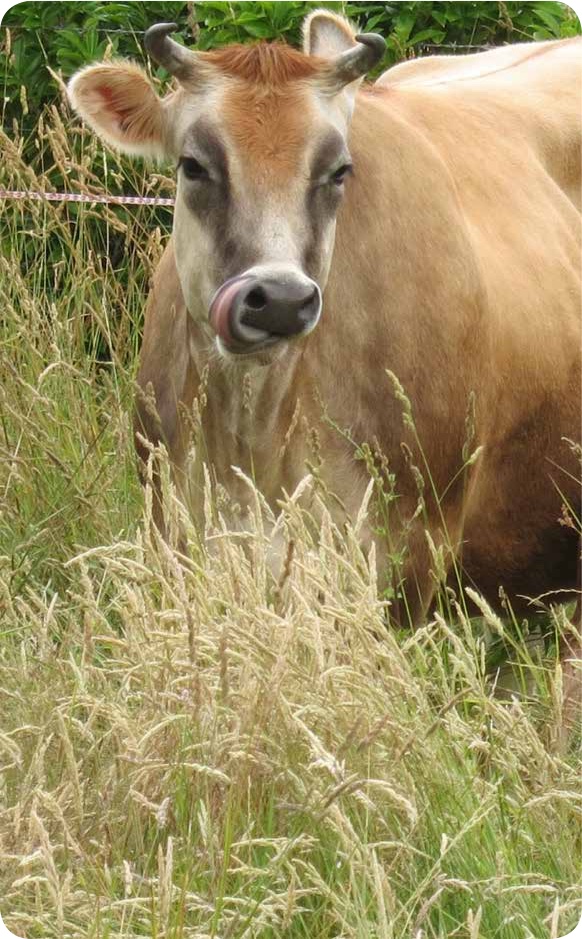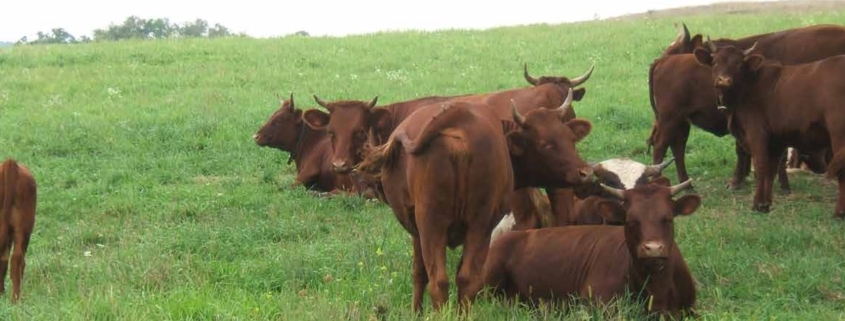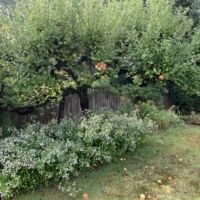Can we move away from dehorning in NZ?
Harvest Article – Autumn 2014
By Marinus La Rooij
In Europe, biodynamic leaders and others are making noise about keeping horns on cattle. Long time biodynamic farmer and Demeter inspector Marinus La Rooij opens the discussion about whether that could become a reality in New Zealand.
The following pages aim to develop and stimulate some thinking on the question of dehorning New Zealand dairy cows and beef cattle. To achieve this, I will put forth most issues in the form of open-ended questions.
Increasing pressure is coming from European biodynamic, organic, consumer and animal welfare organisations to no longer allow dehorning, in particular for Demeter-certified herds. It would be fair to say at the outset, however, that in the context of the EU, the history has been to push actual adoption and implementation of such worthy-but-difficult-to realise intentions ahead and ahead into the future, from deadline to deadline. Nevertheless, the topic needs discussing also in New Zealand, or hard-and-fast rules might well suddenly catch the NZ biodynamic movement unprepared.

In this country we find ourselves somewhat at an advantage, through generally not needing to stable animals over winter, as that means less confinement and less close contact. This advantage may be negated, on the other hand, by New Zealand’s larger herd sizes compared to Europe.
A number of forces are pulling in different directions. Animal welfare, the spiritual BD view of the significance of horns for the cow’s metabolic organisation and milk quality, OSH requirements, the future of herdsmanship, consumer expectations and many other concerns also come into the dehorning question. Below is an attempt to mention all these issues and pull them together into one article, without any claim that this article is comprehensive.
Most biodynamic farmers would agree with the need to stop dehorning in principle, although this paper is not the place to elaborate on the philosophical/ biodynamic reasons for this. Those reasons have to do with the role horns play in the metabolic activity of the cow, and the horns’ resultant usefulness as ‘accumulators’ in preparation making. On top of that, there are serious ethical considerations – as with all mutilations – of minimising suffering and preserving the animals’ integrity and natural behaviours, as well as safeguarding and respecting their intrinsic value.
Here I want to focus not so much on the why, but on questions helpful in how we could make horned herds work, so that perhaps more than the courageous few could go down the path of keeping horned stock in the future. And if the conclusion emerges that we can’t (yet) make horned herds work, well, that is useful to know, too.
This discussion draws on two untranslated documents provided by Demeter International: “Het wezen van de Koe,” Dr Volker Seelbach (original in German), and “De koe en haar hoorns,” Marije Klaver, Wageningen University.
World View
How we see the world determines what kind of decisions we make. If we consider a spiritual world view such as the anthroposophical/biodynamic one, we can begin to recognise the force-streams in the cow’s metabolic organisation and the significance which horns and hoofs have in this complex picture, even though this may not generally be recognised or accepted within mainstream academia. Interestingly, when looking at horn size on various breeds the world over, and especially those in Africa, a trend emerges: the more arid the climate, and the more roughage the animals have to digest, the larger the horns. A growing body of research on the effect of dehorning on milk quality, including allergic reactions, also
exists. Furthermore, as the conventional farming world around us moves more and more towards polled or dehorned stock and so produces fewer and fewer horns, do we even jeopardise the long-term future of biodynamic work worldwide by de-budding or running polled animals on biodynamic farms? After all, without horns, no horn manure preparation (500), and no biodynamic agriculture. What about introducing the polled gene? The horned gene is recessive, but despite this, almost all breeds traditionally were horned. What does this tell us?
Animal Welfare
When horned stock are squeezed into smaller spaces (milking sheds, cattle yards) or when under stress (trying to get to the trough), injuries will occur, to udders, vulvas and skin. Meat damage can result, especially during transport. Carriers may refuse to carry horned stock; abattoirs sometimes refuse to even accept such animals. Dehorning of adult animals is a stressful, painful and bloody process needing veterinary intervention (analgesics, prevention of infection/inflammation), and in a percentage of cases may still lead to infection. Farmers report stock being out of sorts for long periods afterwards (disorientation). Some animals never fully recover or don’t recover at all. Farmers also frequently observe a dulling effect
on the animal, and that it expresses less personality after dehorning. De-budding is much kinder, but some of those long term effects can be expected to be the same. Are there other, kinder methods (elastrators have been suggested) suitable for use prior to transport to the works? How do the injuries inflicted by horns stack up against the horrors of dehorning mature animals? What is the economic cost comparison between the veterinary intervention required for dehorning, and horn damage to udders, vulvas, pelts, meat? How much more general stress do animals experience in a horned herd, compared to a dehorned one, and how does this affect production and general wellbeing? Are there any alternatives such as tipping or covering the horns? Are they useful? Have any withstood the test of time?
Herd Dynamics
When cows ‘lock horns’ in a stoush over dominance, it generally seems to be weight and strength, rather than the biggest horns, that determine the winner. Nevertheless, a smaller, well-horned animal can cause a lot of disruption in a herd. Sideways blows of the head are also common in aggression. The cows seem to maintain a certain radius around themselves which they keep clear of threats with a complex system of signalling. This ‘personal space’ changes after dehorning. Good stockmanship means recognising and reading these signals, and this makes behaviour more predictable and controllable.
Herds with a relatively high average age, in which all animals know their place, are more stable. Such herds tend to be quiet and show less aggression. Instability through changes such as culling, and introducing new stock to a mob (whether bought-in stock or own replacements) inevitably leads to jostling to (re-) establish rank. What are the best ways in which this could be eased? For example, first providing visual contact only, before physically allowing animals to run together, or only joining new animals when the cows are at a fresh break, so they are initially more interested in the feed?
Special problems can be expected in partially dehorned mobs. Prohibition of dehorning would lead to an especially difficult transitional management period lasting five or more years, until all stock carry horns again. Horned mob sizes need to be such that each cow can know the others individually and place each one in the complex web of social connections that makes up the mob. Estimates by observers vary rather widely between 45 -150 animals, for this to be the case. How does that fit in with NZ farming systems? How practical is it for a farm to run several smaller mobs so that each animal can know all the others? A horned herd will require stronger selection pressure against flightiness, nervousness, aggression, and also against unacceptable horn shape (inward curving preferred). It is interesting that ranking has been observed to change significantly in a herd of which all animals were dehorned at the same time. Perhaps this may be explained by the differing long term effects on different animals. Also, the ranking can change, depending on the situation. For example, near water troughs the ranking may be different from the one in the yard. Some animals will simply be obstructive, seemingly for the hell of it, and prevent others from getting to the troughs or licks, or gates.

Handling and Milking Facilities
Yard design and milking sheds have come a long way to achieve better flow-through and fewer places where animals can be bailed up by others. But improvements to existing unsatisfactory facilities are disruptive and expensive. Temple Grandin has achieved fame as a designer for cattle yards par excellence in the U.S. Can her principles and “cow’s-eye view” approach be adopted in the New Zealand situation? Does robotic, on-demand milking perhaps provide a panacea in the milking shed, where cows amble up to the shed and get milked robotically whenever they like, with a minimum of human intervention, stress and congestion? Or will the horns do too much damage to the expensive robotics?
Animal Telepathy
One of the source articles (see above) mentions an intriguing possibility: Is there a place for developing a form of animal telepathy, in an effort to communicate with the stock and find out where the ranking and aggression problems lie and how they can be remedied? Is this perhaps a future critical aspect of biodynamic herdsmanship? Can this be required of farmers and milkers, or is this something at which people will have to arrive in their own good time, out of their own inner development, their own stockmanship? In a sense this can be seen as the opposite approach to robotic milking: low tech, personality-based “magical” farming with intense personal involvement and monitoring (Luciferic), versus robotic, high-tech, with minimum human intervention and less farmer consciousness and observation (Ahrimanic). Which is the more appropriate in a biodynamic setting? Or do we need to seek for a balance here and employ both to some extent where appropriate? Can we perhaps even say that to the extent that we utilise and abdicate our responsibility to soulless technology, to that same extent do we also need to develop our intuitive and psychic/telepathic faculties in relation to our animals?
Occupational Safety
Farmers are required to provide a safe working environment for their staff. How real is the contention that with a horned herd, the farmer has not taken every reasonable and possible step to achieve this? Have there been test cases? How many human injuries actually result annually from working with horned stock? How serious are these?
Conclusion
The above questions are some of the ones I think we will need to grapple with, if maintaining horned herds is to become a reality in the future. But even putting that prospect aside for the moment, perhaps these questions may raise awareness of stressors in the herd, and may cause farmers to make small incremental changes, such as less crowding together and more careful use of the backing gate, changed use or no use of dogs, etc. The cow by nature is a placid animal, and anything that allows her to express and live out of that placidity has to be worth considering.
Marinus La Rooij has been a Demeter inspector for many years and previously did similar work for BioGro. He has managed biodynamic farms in several parts of NZ, raising vegetables and livestock,and is a former chair of the Biodynamic Association. He was instrumental in the creation of Demeter certification in New Zealand in the early 1980s.



